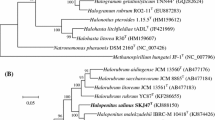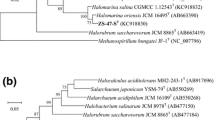Abstract
Two halophilic archaeal strains, R60T and R61, were isolated from the brine of salted brown alga Laminaria. Cells of the two strains were observed to be rod-shaped, stain Gram-negative and to lyse in distilled water. Strain R60T was found to contain gas vacuoles and to produce pink-pigmented colonies, while strain R61 lacked gas vacuoles and produces red-pigmented colonies. Both strains were found to be able to grow at 20–50 °C (optimum 30 °C), at 1.7–4.8 M NaCl (optimum 2.6–3.1 M NaCl), at 0–1.0 M MgCl2 (optimum 0.005–0.1 M MgCl2) and at pH 6.0–9.5 (optimum pH 7.0). The major polar lipids were identified as phosphatidylglycerol, phosphatidylglycerol phosphate methyl ester, phosphatidylglycerol sulfate and one major glycolipid chromatographically identical to a sulfated mannosyl glucosyl diether produced by Halorubrum members of the Halobacteriaceae. The 16S rRNA gene sequences of the two strains were 99.9 % identical, showing 94.6–98.0 % similarity to those of members of the genus Halorubrum. The EF-2 gene similarity between strains R60T and R60 was 100 % and showed 84.6–94.5 % similarity to those of members of the genus Halorubrum. The DNA G+C contents of the two strains were determined to be 63.0 mol %. The DNA–DNA hybridization value between strain R60T and strain R61 was 92 % and the two strains showed low DNA–DNA relatedness with the most related members of Halorubrum. The phenotypic, chemotaxonomic and phylogenetic properties suggest that strain R60T (= CGMCC 1.12689T = JCM 30040T) and strain R61 (= CGMCC 1.12696) represent a novel species of the genus Halorubrum, for which the name Halorubrum laminariae sp. nov. is proposed.

Similar content being viewed by others
References
Abriouel H, Benomar N, Lucas R, Gálvez A (2011) Culture-independent study of the diversity of microbial populations in brines during fermentation of naturally-fermented Aloreña green table olives. Int J Food Microbiol 144:487–496
Cui HL, Lin ZY, Dong Y, Zhou PJ, Liu SJ (2007) Halorubrum litoreum sp. nov., an extremely halophilic archaeon from a solar saltern. Int J Syst Evol Microbiol 57:2204–2206
Cui HL, Zhou PJ, Oren A, Liu SJ (2009) Intraspecific polymorphism of 16S rRNA genes in two halophilic archaeal genera, Haloarcula and Halomicrobium. Extremophiles 13:31–37
Cui HL, Gao X, Yang X, Xu XW (2010) Halorussus rarus gen. nov., sp. nov., a new member of the family Halobacteriaceae isolated from a marine solar saltern. Extremophiles 14:493–499
Cui HL, Yang X, Mou YZ (2011) Salinarchaeum laminariae gen. nov., sp. nov.: a new member of the family Halobacteriaceae isolated from salted brown alga Laminaria. Extremophiles 15:625–631
De Ley J, Cattoir H, Reynaerts A (1970) The quantitative measurement of DNA hybridization from renaturation rates. Eur J Biochem 12:133–142
Dussault HP (1955) An improved technique for staining red halophilic bacteria. J Bacteriol 70:484–485
Gonzalez C, Gutierrez C, Ramirez C (1978) Halobacterium vallismortis sp. nov. an amylolytic and carbohydrate-metabolizing, extremely halophilic bacterium. Can J Microbiol 24:710–715
Gutiérrez C, González C (1972) Method for simultaneous detection of proteinase and esterase activities in extremely halophilic bacteria. Appl Microbiol 24:516–517
Han D, Cui HL (2014a) Halosimplex pelagicum sp. nov. and Halosimplex rubrum sp. nov., isolated from salted brown alga Laminaria, and emended description of the genus Halosimplex. Int J Syst Evol Microbiol 64:169–173
Han D, Cui H-L (2014b) Haloplanus litoreus sp. nov. and Haloplanus ruber sp. nov., from a marine solar saltern and an aquaculture farm, respectively. Antonie Van Leeuwenhoek 105:679–685
Huß VAR, Festl H, Schleifer KH (1983) Studies on the spectrophotometric determination of DNA hybridization from renaturation rates. Syst Appl Microbiol 4:184–192
Marmur J, Doty P (1962) Determination of the base composition of deoxyribonucleic acid from its thermal denaturation temperature. J Mol Biol 5:109–118
McDade JJ, Weaver RH (1959) Rapid methods for the detection of gelatin hydrolysis. J Bacteriol 77:60–64
McGenity TJ, Grant WD (1995) Transfer of Halobacterium saccharovorum, Halobacterium sodomense, Halobacterium trapanicum NRC 34021 and Halobacterium lacusprofundi to the genus Halorubrum gen. nov., as Halorubrum saccharovorum comb. nov., Halorubrum sodomense comb. nov., Halorubrum trapanicum comb. nov., and Halorubrum lacusprofundi comb. nov. Syst Appl Microbiol 18:237–243
Minegishi H, Kamekura M, Itoh T, Echigo A, Usami R, Hashimoto T (2010) Further refinement of Halobacteriaceae phylogeny based on the full-length RNA polymerase subunit B’ (rpoB ’) gene. Int J Syst Evol Microbiol 60:2398–2408
Mou YZ, Qiu XX, Zhao ML, Cui HL, Oh D, Dyall-Smith ML (2012) Halohasta litorea gen. nov. sp. nov., and Halohasta litchfieldiae sp. nov., isolated from the Daliang aquaculture farm, China and from Deep Lake, Antarctica, respectively. Extremophiles 16:895–901
Mwatha WE, Grant WD (1993) Natronobacterium vacuolata sp. nov., a haloalkaliphilic archaeon isolated from Lake Magadi, Kenya. Int J Syst Bacteriol 43:401–404
Oren A, Ventosa A, Grant WD (1997) Proposed minimal standards for description of new taxa in the order Halobacteriales. Int J Syst Bacteriol 47:233–238
Oren A, Arahal DR, Ventosa A (2009) Emended descriptions of genera of the family Halobacteriaceae. Int J Syst Evol Microbiol 59:637–642
Qiu X-X, Zhao M-L, Han D, Zhang W-J, Dyall-Smith ML, Cui H-L (2013) Taxonomic study of the genera Halogeometricum and Halosarcina: transfer of Halosarcina limi and Halosarcina pallida to the genus Halogeometricum as Halogeometricum limi comb. nov. and Halogeometricum pallidum comb. nov., respectively. Int J Syst Evol Microbiol 63:3915–3919
Stackebrandt E, Goebel BM (1994) Taxonomic note: a place for DNA–DNA reassociation and 16S rRNA sequence analysis in the present species definition in bacteriology. Int J Syst Bacteriol 44:846–849
Tamura K, Peterson D, Peterson N, Stecher G, Nei M, Kumar S (2011) MEGA5: molecular evolutionary genetics analysis using maximum likelihood, evolutionary distance, and maximum parsimony methods. Mol Biol Evol 28:2731–2739
Yim KJ, Cha I-T, Lee H-W, Song HS, Kim K-N, Lee S-J, Nam Y-D, Hyun D-W, Bae J-W, Rhee S-K, Seo M-J, Choi J-S, Choi H-J, Roh SW, Kim D (2014) Halorubrum halophilum sp. nov., an extremely halophilic archaeon isolated from a salt-fermented seafood. Antonie Van Leeuwenhoek 105:603–612
Zhang W-J, Cui H-L (2014) Halorubrum salinum sp. nov., isolated from a marine solar saltern. Arch Microbiol 196:395–400
Zhaxybayeva O, Stepanauskas R, Mohan NR, Papke RT (2013) Cell sorting analysis of geographically separated hypersaline environments. Extremophiles 17:265–275
Acknowledgments
This work was supported by the National Natural Science Foundation of China (No. 31370054), the grant from China Ocean Mineral Resources R & D Association (COMRA) Special Foundation (DY125-15-R-03), the Qinglan Project of Jiangsu province and a project funded by the Priority Academic Program Development of Jiangsu Higher Education Institutions (PAPD).
Author information
Authors and Affiliations
Corresponding author
Electronic supplementary material
Phase-contrast micrographs of strains R60T and R61, thin-layer chromatograms of strains R60T, R61, Halorubrum saccharovorum CGMCC 1.2147T and Halorubrum aidingense CGMCC 1.2670T, are available as supplementary materials.
Rights and permissions
About this article
Cite this article
Han, D., Cui, HL. Halorubrum laminariae sp. nov., isolated from the brine of salted brown alga Laminaria . Antonie van Leeuwenhoek 107, 217–223 (2015). https://doi.org/10.1007/s10482-014-0319-9
Received:
Accepted:
Published:
Issue Date:
DOI: https://doi.org/10.1007/s10482-014-0319-9




